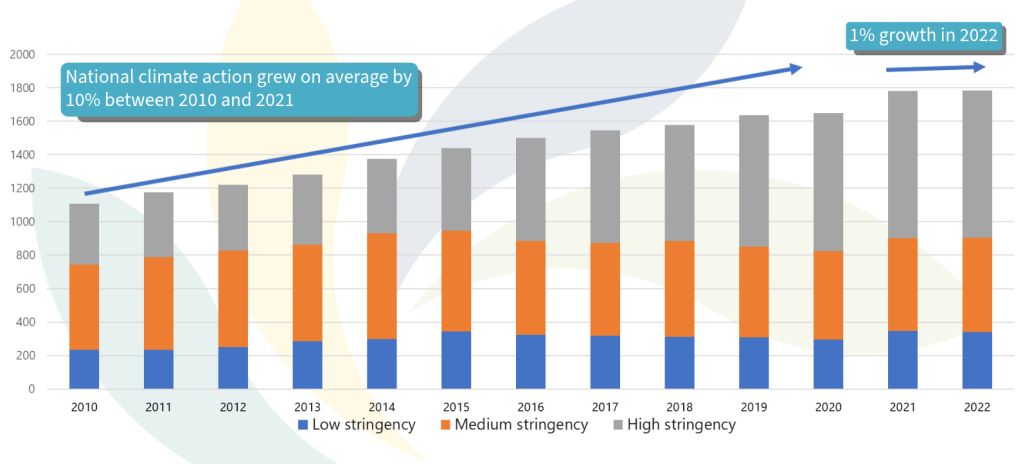Environment Focus
An environmental lens on policies for better lives
Charting climate action through data insights
By Daniel Nachtigall, OECD Environment Directorate

As we turn the page on the hottest year on record, communities across the globe are facing the accelerating impacts from climate change. 2023 witnessed unprecedented extreme weather events, from heatwaves, to wildfires, floods, and hurricanes. From Cyclone Daniel in Libya to raging wildfires in North America and torrential rains in Spain and Europe, the signs are crystal clear—we’re in the midst of a climate emergency.
Implementing effective climate action is key to reducing greenhouse gas (GHG) emissions and to achieving net-zero targets and the temperature goals of the Paris Agreement. Limiting global warming to 1.5°C or 2°C is paramount to avoid tipping points that could lead to irreversible changes in the climate. The burden of not pushing humanity outside this safe operating space lies largely with governments and political decisionmakers. What have governments actually done to fight climate change? The Climate Action Monitor 2023, an output of the OECD International Programme for Action on Climate (IPAC), provides important insights on how governments’ climate action evolved over the last few decades.
The Monitor’s analysis is based on the Climate Actions and Policies Measurement Framework (CAPMF), which provides consistent and harmonised climate policies tracking. With over 300,000 data points, the CAPMF tracks 75% of policy instrument types mentioned by the IPCC for 50 OECD and OECD partner countries and the European Union from 1990 to 2022. These countries jointly account for two thirds of global greenhouse gas (GHG) emissions.
Growth in climate action slowed down significantly in 2022
The CAPMF shows that the pace of growth in “climate action” slowed down in 2022, as measured by the number of adopted policies and their respective policy stringency. While climate action has been growing by 10% per year between 2000 and 2021, this growth rate fell to merely 1% in 2022 (Figure 1), marking a significant break from the earlier trend of steady growth observed by the CAPMF.
This slowdown of climate action in 2022 is the result of a mix of geopolitical and macroeconomic shocks combined with national circumstances. On the one hand, the energy crisis prompted governments to ramp up fossil fuel support to unprecedented levels while postponing planned climate actions such as increases in carbon pricing or the phasing out of fossil fuel infrastructure. Moreover, the financial capacity of many governments to further invest in low-carbon technologies was constrained due to heightened government expenditure on COVID-19 recovery plans and increased interest rates aimed at controlling inflation.
On the other hand, the energy crisis also spurred increased climate action. Some countries seized the occasion to adopt more ambitious targets on renewables and energy efficiency, amid concerns over energy security and reliance on fossil fuels. However, the overall balance across the 50 countries tracked by the CAPMF resulted in a notable departure from the earlier aggregate upward trend.
Figure 1. Overall climate action slowed down significantly in 2022

Differing degrees of climate action across countries
The aggregate trend also masks significant differences across countries and policy instruments. In fact, 30 out of the 50 countries monitored by the CAPMF – accounting for 29% of global GHG emissions – expanded their climate action in 2022, albeit to a much lower degree than the expansion in previous years.
The growth seen in 2022 largely stemmed from new or improved commitments to net-zero, more robust regulatory actions, and progress in international climate policy frameworks. For example, India submitted its Nationally Determined Contribution (NDC) with a 2070 net-zero target, Chile enacted its net-zero target into legislation, and the European Union significantly amplified its climate efforts through the ‘Fit for 55’ package. This package encompasses, among other elements, revisions to its Emissions Trading Scheme (ETS), as well as new rules to bolster energy efficiency and the use of renewables.
Governments must do more to bend the emissions curve
The growing impacts of climate change observed in 2023 should be a strong wake up call for leaders to step up climate action to drive the transformational change that is necessary to reach the temperature goals of the Paris Agreement. This is even more important as global carbon dioxide emissions are expected to further increase, having reached the highest level ever recorded in 2023 according to the recent Global Carbon Budget report.
The good news is that all countries still have multiple policy options available to bend their national emissions curve. The CAPMF can support policymakers to identify policy gaps or policy areas in which existing policies can be strengthened. In addition, ongoing OECD work under the Inclusive Forum on Carbon Mitigation Approaches can provide governments with key recommendations by informing about which policy approaches are most effective in reducing emissions.
Further reading
- Read the Climate Action Monitor 2023 report
- Read the working paper on “The climate actions and policies measurement framework”
- Watch the replay of the related COP28 event
- Explore all the CAPMF data
- Visit the website and dashboard of the International Programme for Action on Climate (IPAC)
